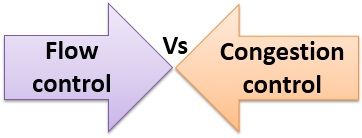Main Differences between the Flow Control and Congestion Control

Flow control and congestion control are two distinct concepts in computer networking, each serving different purposes and addressing different aspects of network communication. Here are the main differences between flow control and congestion control:
-
Purpose:
- Flow Control: Flow control is primarily concerned with regulating the flow of data between two communicating devices to prevent the sender from overwhelming the receiver with data. Its main goal is to ensure that the receiving device can process incoming data at a rate that matches its processing capabilities, preventing buffer overflow and data loss.
- Congestion Control: Congestion control, on the other hand, focuses on managing network traffic and resources to prevent congestion in the network. Its primary objective is to regulate the flow of traffic within the network to avoid network collapse, packet loss, increased latency, and degraded performance.
-
Scope:
- Flow Control: Flow control mechanisms operate at the data link layer (Layer 2) or the transport layer (Layer 4) of the OSI model. They are typically implemented between two directly connected devices, such as between a sender and receiver in a point-to-point communication scenario.
- Congestion Control: Congestion control mechanisms operate at the network layer (Layer 3) or the transport layer (Layer 4) of the OSI model. They are concerned with managing traffic flow across multiple network devices and links, ensuring efficient utilization of network resources and preventing congestion in the network as a whole.
-
Granularity:
- Flow Control: Flow control mechanisms regulate the flow of data on a per-connection basis between two specific devices. They focus on controlling the rate of data transmission between the sender and receiver based on the receiver's ability to process incoming data.
- Congestion Control: Congestion control mechanisms manage traffic flow across the entire network, considering multiple connections and devices. They aim to regulate the overall rate of traffic flow within the network to prevent congestion and ensure fair resource allocation among competing users or applications.
-
Mechanisms:
- Flow Control: Flow control mechanisms include techniques such as sliding window protocols, stop-and-wait protocols, and window-based flow control mechanisms used in transport layer protocols like TCP. These mechanisms regulate the flow of data between sender and receiver, ensuring that the sender does not overwhelm the receiver with data.
- Congestion Control: Congestion control mechanisms include techniques such as traffic policing and shaping, queue management, explicit congestion notification (ECN), and quality of service (QoS) management. These mechanisms manage traffic flow within the network, preventing congestion by regulating the rate of data transmission, prioritizing traffic, and managing network resources.
In summary, while both flow control and congestion control are essential for efficient network communication, they operate at different layers of the OSI model, have different scopes and purposes, and use different mechanisms to achieve their goals. Flow control focuses on regulating the flow of data between specific devices, while congestion control focuses on managing traffic flow within the network to prevent congestion and ensure efficient resource utilization.
Thank you,
